Graham Reid | | 7 min read
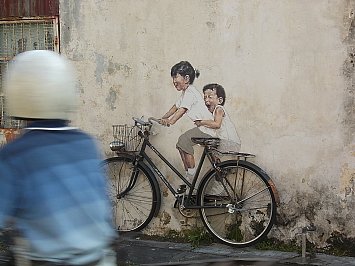
How often do we go back to countries we have visited previously? Sometimes life is too short and money too tight, but my husband and I decided to go back to Malaysia recently and sample more variety after a visit to Kuala Lumpur a year ago.
He had visited Langkawi and found it a pleasant laid back environment somewhat reminiscent of peaceful visits to Greek islands, with incredibly cheap food, safe travel by motorscooter . . . but with not a great deal to do.
He had also undertaken some ‘medical tourism’ and had extensive dental work carried out in the suburbs of Kuala Lumpur which he is very happy with.
You might say he's intrepid. I’m not.
So we were recommended to go to Penang by other travellers . . . by which they meant the more picturesque island section of it.
Georgetown, the major city and capital of Penang was named as a World Cultural Heritage Site by UNESCO in 2008. This recognises the high concentration of distinctive buildings in a relatively small area and how they reflect the variety of influences on the city and its past role as a trading post linking east and west.
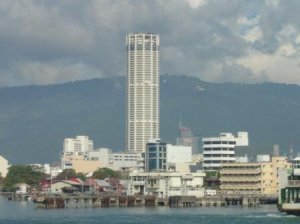 There is a wealth of grand colonial
official buildings, art deco style buildings, Chinese shop houses,
mansions and villas in various styles, temples, churches and mosques,
a fort, a harbour setting, a variety of houses on Penang Hill which
reflect an English influence - and many more.
There is a wealth of grand colonial
official buildings, art deco style buildings, Chinese shop houses,
mansions and villas in various styles, temples, churches and mosques,
a fort, a harbour setting, a variety of houses on Penang Hill which
reflect an English influence - and many more.
And yes, it’s mixed in with a combination of huge closed or open drains some of which stink the way Singapore used to – to cope with the torrential rain.
You do have to learn to keep watching your feet and be fit enough to hop over them at times. Also the modern architecture, like most places in the world, is not always pleasant and the apartment blocks can be upsetting, [size, lack of maintenance.] Mould is a great problem; Auckland has a minor incidence of this compared with Malaysia.
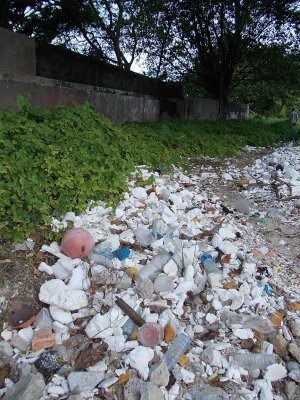 There
appears to be no cohesive method to collect and dispose of rubbish (right, on the harbourside) although I saw discussion of this problem in the local newspaper.
There
appears to be no cohesive method to collect and dispose of rubbish (right, on the harbourside) although I saw discussion of this problem in the local newspaper.
The roads are pretty good but Georgetown has a tortuous one way system which needs patience and GPS on your phone, and you have to get used to the fact that everyone drives horrifyingly close to each other.
Traffic is heavy at peak times and motor scooters are very numerous and their drivers often exceedingly reckless. We saw many hair’s-breadth manoeuvres and what appeared to be one death. The onus seemed to be on car drivers to avoid accidents, not the other way around. Despite that we drove around the island for two weeks, quickly developing nerves of steel but didn’t see any bad car smashes. Driving on the left does make it easier.
We also drove on the motorway from KL to Georgetown - a high quality road but with some local rules. If someone pulls up close on your tail you move over no matter what speed you are doing. 110km per hour is the limit, but not for all! There was entertainment in the mannikins dressed in road workers’ gear who waved at you if there was a hazard or roadworks. Quite funny the first few times.
We didn’t bother driving the five-six hours back as it wasn’t particularly interesting – views dominated by oil palms. We flew instead for 40 minutes with a perfectly acceptable local airline which is a cheaper subsidiary of Malaysia Airlines.
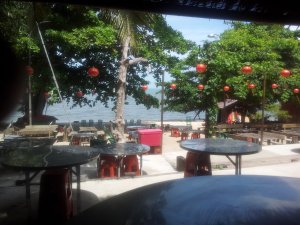 Driving however gave us a lot of
flexibility - and coolness on the way, which aided our ability to
keep going in 30-32 degree heat. The humidity is not a problem but the heat is. Each day we tended to make one trip
in the cooler morning and one later after a cool down back at the
hotel. It was apparently the rainy season but we had only a couple of
days when it rained heavily.
Driving however gave us a lot of
flexibility - and coolness on the way, which aided our ability to
keep going in 30-32 degree heat. The humidity is not a problem but the heat is. Each day we tended to make one trip
in the cooler morning and one later after a cool down back at the
hotel. It was apparently the rainy season but we had only a couple of
days when it rained heavily.
Some highlights were the guided tour of The Blue House - Cheong Fat Tze’s mansion, the Museum where we learnt a lot about all the ethnic groups in Penang, the art gallery and some private galleries which gave us a revealing look at how Malaysians see their world, the largest clan house and temple - Khoo Kongsi, Little India, Tropical Spice Gardens, Penang Hill and its gondola ride, where it is reputed to be about 5 degrees cooler, and the incongruity of lunch at the expensive Hard Rock Café.
A wander around Hard Rock Hotel where the pools were gorgeous and everything was pristine and modern was an interesting contrast.
This area of Batu Ferringhi on the northern coast appeared to be where most white tourists were accommodated. Apart from these hotel-controlled beaches many others are polluted , subject to jellyfish infestation or covered in rubbish.
We also enjoyed a drive to a southern coastal fishing area Teluk Kumbar with much of the housing being traditional Malay style and very laid back compared with the city.
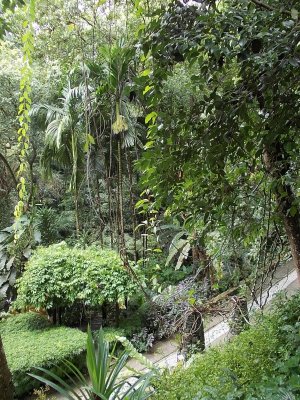 Another trip took us to the hills and the fruit orchard area –
it was the durian harvest season and being the weekend it was very
busy with families taking a break together.
Another trip took us to the hills and the fruit orchard area –
it was the durian harvest season and being the weekend it was very
busy with families taking a break together.
There is a ban on this smelly but delicious fruit in town and in hotels especially. Fresh ones seemed not too smelly, but the other day I saw some in the Sunnynook Fruit and Vegetable shop on Link Drive on Auckland's North Shore which were a bit hard to take when close by. Now I know why the ban exists.
Another day we headed back over the impressive 13.5 km bridge that links Georgetown to the mainland. The so-called attractions of Auto City and the Largest Bird Park in Malaysia turned out to be unappealing so we were reduced to partaking of Subway and Starbucks fare, which wasn’t so bad as far as tourist experiences go.
Tesco supermarkets and Cool Storage shops placed in malls are numerous when you need self catering, but you can try all sorts of food while there as well.
We managed to cover such Penang classics as Char Koay Teow, Penang Laksa and Mee Goreng
Plus with the range of Indian, Thai, Japanese, Korean, Chinese, Malay and Nonya dishes it is hard to stop sampling! I was delighted to find a dish that Rick Stein raves about at a mall food stall – green papaya salad. It became my test of the standard of each café.
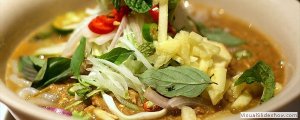 We both enjoyed pretty much
everything and my husband specially enjoyed all the Indian food on
offer. We were reasonably careful where we ate as he had suffered
serious food poisoning on a previous trip. We noticed that a lot of
the food was starting to be cooked around 10 am in time for the lunch
time rush so aimed to eat lunch fairly early so it had no time to go
off. Plus we mostly had food which was cooked and hot and there was
a proper kitchen, not road side stalls.
We both enjoyed pretty much
everything and my husband specially enjoyed all the Indian food on
offer. We were reasonably careful where we ate as he had suffered
serious food poisoning on a previous trip. We noticed that a lot of
the food was starting to be cooked around 10 am in time for the lunch
time rush so aimed to eat lunch fairly early so it had no time to go
off. Plus we mostly had food which was cooked and hot and there was
a proper kitchen, not road side stalls.
The atmosphere in general is trouble free; people seem to co-exist peacefully – that and the equality given to the three main cultures in Malaysia is a great part of the attraction for me. In one short lift journey I heard two women communicate in a combination of 3 languages.
Judging by the articles and Letters to the Editor there is a strong thoughtful streak to society from all ethnicities and a desire to plan for a secure and prosperous future for all. In education they are very pleased to note they have 90% participation in free primary education and 80% in secondary. Maybe these figures are a little fudged but there were certainly hordes of secondary school pupils in the central area of town at a number of schools. Likewise they are concerned that their economy should not be supported by just their cheap petroleum [self sufficient and about half the price of New Zealand’s at the pump] and palm oil products.
We also noted a fair number of invitations to use Malaysia as a health and retirement destination. As a foreigner you are allowed to buy property but it has to cost $1m Ringgits or more [approx 393,000 NZD]. Modern houses and apartments on offer were fine but did not live up to our imagined ideal of a Malay house.
If you want a treat you should
stay at one of the hotels at Batu Ferringhi or the Eastern &
Oriental in the heritage area by the sea. We made a compromise
between heritage boutique hotels and modernity by staying at the
Bayview [opposite the E&O and with a view of the harbour.] Yes I
thought of Graham’s collection of photos from the hotel window as I
soaked up the sunrises and sunsets and the passing cruise ships. It
was fine if you didn’t worry too much about the dripping aircon and
a few other details and was very reasonably priced.
Our last night in Malaysia was
spent at the sumptuous Pan Pacific at Kuala Lumpur airport. Well
worth it – and lovely food there too.
A great quote from Jules Olders’ blog credited to E. L. Doctorow: "Writing is like driving at night in the fog. You can only see as far as your headlights, but you can make the whole trip that way."
Well, I feel that travel is that way too, and mostly enjoyable, especially when you look back on it. I probably won’t go to Malaysia again but Georgetown and its contrast with surrounding areas is a distinctive and interesting location highly ranked by travel surveys - and some commentators I have read advise visiting before it becomes too tidy and all buildings are totally restored.
Angela Soutar is an Auckland librarian fascinated by books in all forms and at all levels and is a persistent but bumbling ukulele player.Other Voices Other Rooms is an opportunity for Elsewhere readers to contribute their ideas, passions, interests and opinions about whatever takes their fancy. Elsewhere welcomes travel stories, think pieces, essays about readers' research or hobbies etc etc. Nail it in 1000 words of fewer and contact graham.reid@elsewhere.co.nz.
See here for previous contributors' work. It is wide-ranging.

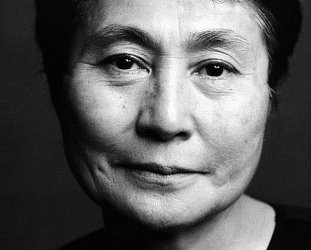
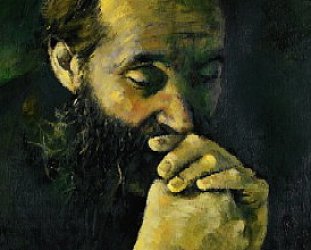
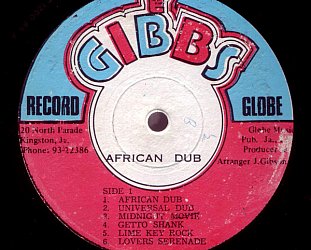
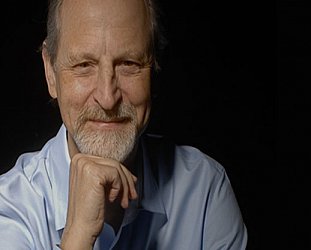
post a comment